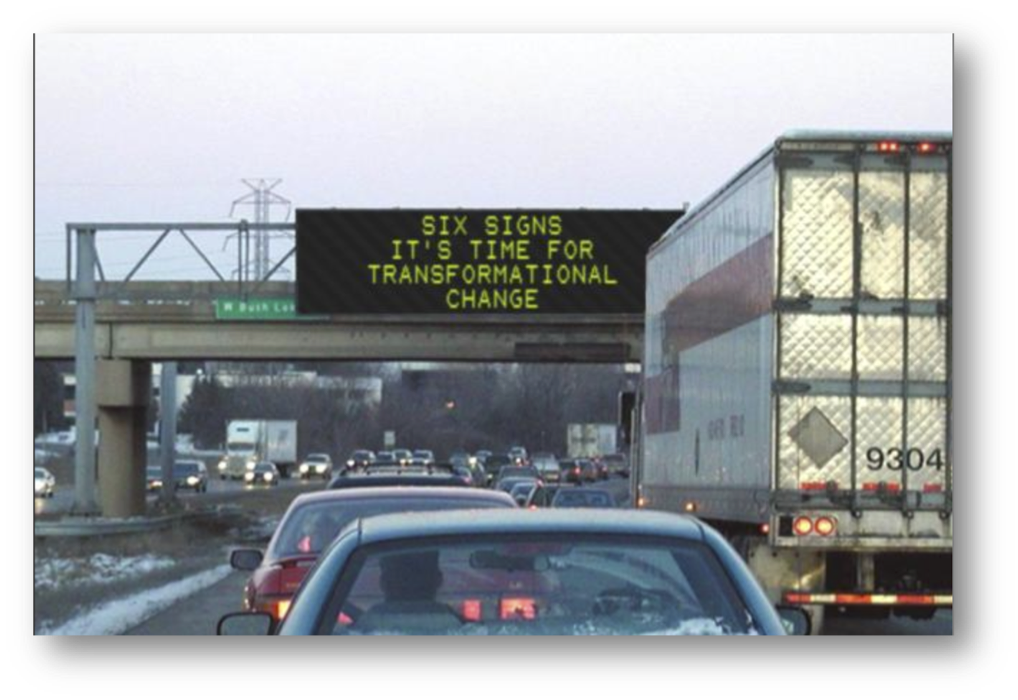
14 Jun 6 Signs It’s Time for Transformational Change
Is it time for transformational change — or is incremental change more appropriate? Too often leaders mistake one for the other, and wind up doing too little too late, or squashing the proverbial fly with a sledgehammer.
Neither situation turns out well, unfortunately.
Yes, as the old saying goes, “change is inevitable.” However, not all approaches to change are appropriate for all situations. Sometimes, Incremental Change is the right answer — especially when you have a great situation that you want to make even greater. This is an excellent time to look at process optimization (like LEAN, or Six Sigma), or continuous quality programs (like Malcolm Baldridge).
However, when you’ve got deep, pervasive and maybe even dysfunctional issues, incremental changes fail miserably. If you’ve got these things going on, it’s time for something else. Let’s look at the “6 Signs It’s Time for Transformational Change.”
Sign 1.
It’s clear to MANY that you’re stuck.
Whatever change effort you’ve attempted to implement has run aground, gotten high-centered, or is spinning its wheels uncontrollably in the mud. Progress has ended, and there’s groaning related to falling backward. It’s likely that your organization’s ship has lost its rudder, and the wind is blowing you all over the place. No one is entirely sure which way is the “right” way anymore, and no one is offering any suggestions any longer. You’re stuck.
Sign 2.
Interpersonal conflict has become destructive and punitive.
Mistakes are used as weapons, file folders of “just-in-case” emails are filling desk drawers, and toxic conversations are typical at lunchtime. Employee grievances are overloading the HR department, and many staff members are “on probation.” In addition, your definition of empowerment is having managers make their employees lives miserable by picking nits, bullying, and in some extreme cases intimidating to the point of harassment. The manager is “empowered” to be a pain in the backside.
Sign 3.
Trust is not only absent, it’s negative.
Company meetings are torturous, but you’re afraid to miss them for fear of missing someone’s underhanded comment, or suggestion that you’re not doing your job. You keep ALL of your emails, and cross-reference them by “who’s my nemesis today.” Few people “step into traffic” to do what’s needed to be done, when it’s needed to be done. Further, everyone wears “no-stick” clothing to work, and whenever something does go badly, the one with the “least no-stick” surface gets the blame.
Sign 4.
We’re great at planning — we just suck at doing what we plan.
Beautiful, framed versions of vision and mission statements adorn your elevator lobbies and conference rooms. Three-ring binders are chocked full of dust-collecting strategic plans. Employees shake their heads in agreement during webinars and mandatory all-staff meetings. You’ve paid TONS of money for offsite meetings and consulting fees, and still the organization can’t figure out why plans never turn into reality. “Must be the employees’ fault” is heard frequently in meetings of top management.
Sign 5.
The auditors and the legal department are in charge of strategy.
Oversight and bureaucracy are seen in epidemic proportions in your organization. Decision quality has not improved, mind you, but the number of people involved in each decision has tripled. When you do make decisions, you spend considerable time ensuring you have a defensible position should the decision go sideways in the future. The “bureaucratic virus” has infected managers at many levels in the organization. Symptoms include hiding behind policy (no matter how outdated), pushing decisions to committees, and delaying any risk until “someone else” is clearly on the hook.
Sign 6.
Employee engagement? We don’t need engagement — we need results!
Your most recent employee survey(s) indicates most of your staff would find another job immediately if they were able to do so. Company “events” (like picnics) are a joke, and there’s little REAL recognition for the value the employees bring to their jobs. Employee morale is at, or near, an all-time low. Most employees feel as if robots could do their jobs as well or better than they could. The culture represents the “land of the living dead,” as zombies push paper and enter transactions.
Now What?
If you have a great situation you want to make greater, “sometimes” transformational change can be helpful — particularly if you’ve hit the wall. However, don’t confuse times and places where incremental change is the best idea with the notion that ALL change should be transformational.
In other words, keep your sledgehammers for breaking rocks, not for “killing flies.”
Now — that said — the first step toward solving a deep, long-held, pervasive problem is admitting you have one. That can be a transformational change all by itself!
For more information about how to ENSURE change will fail, read my blog on the “Top 10 Ways to Ensure Epic Organizational Change Failures.”



No Comments